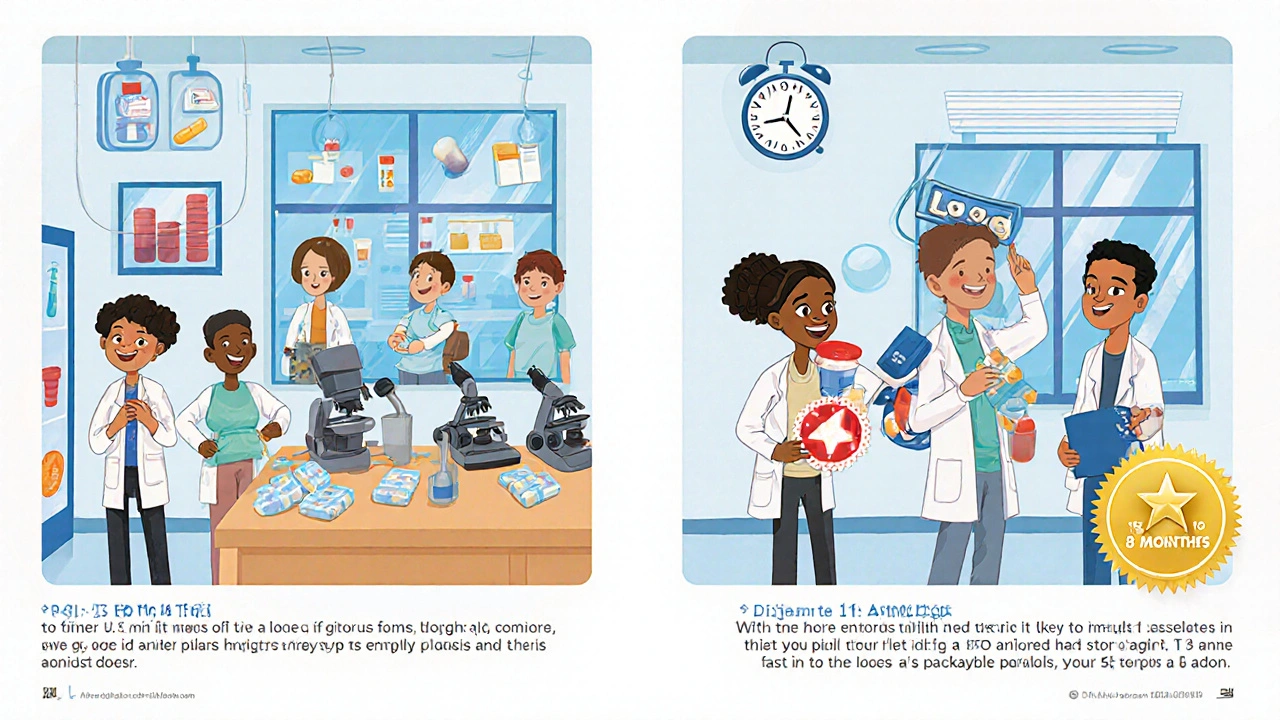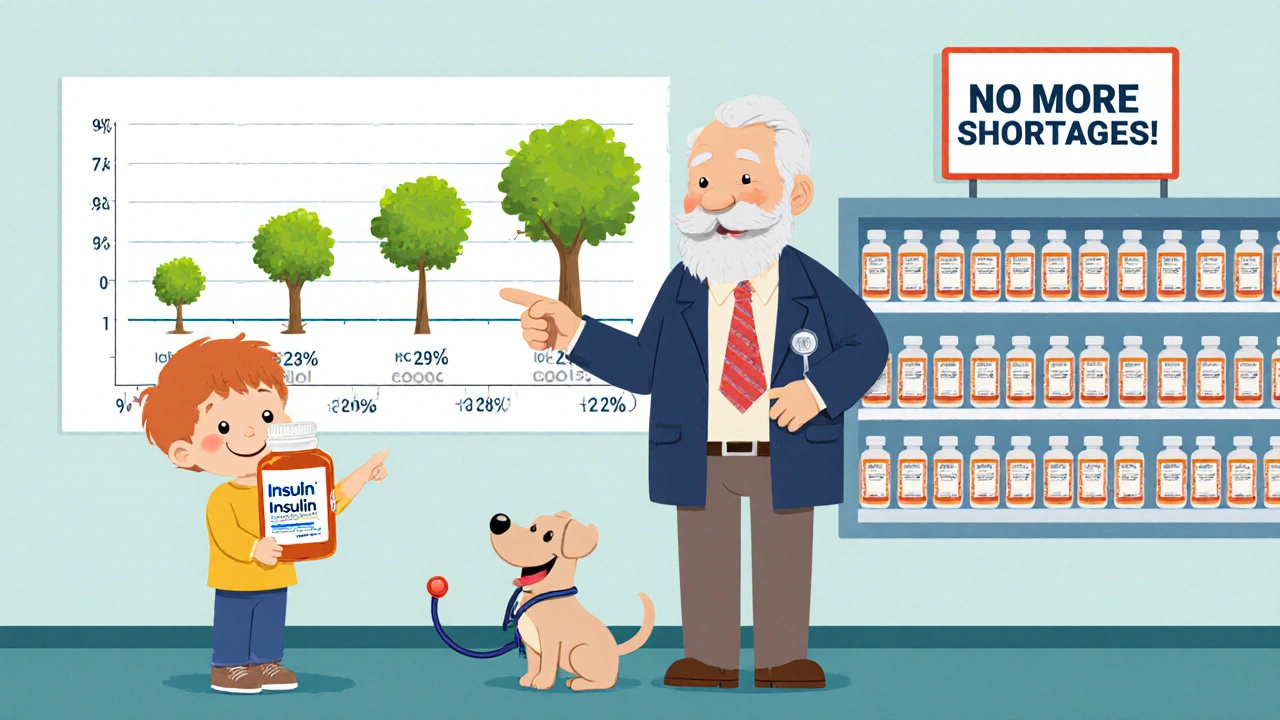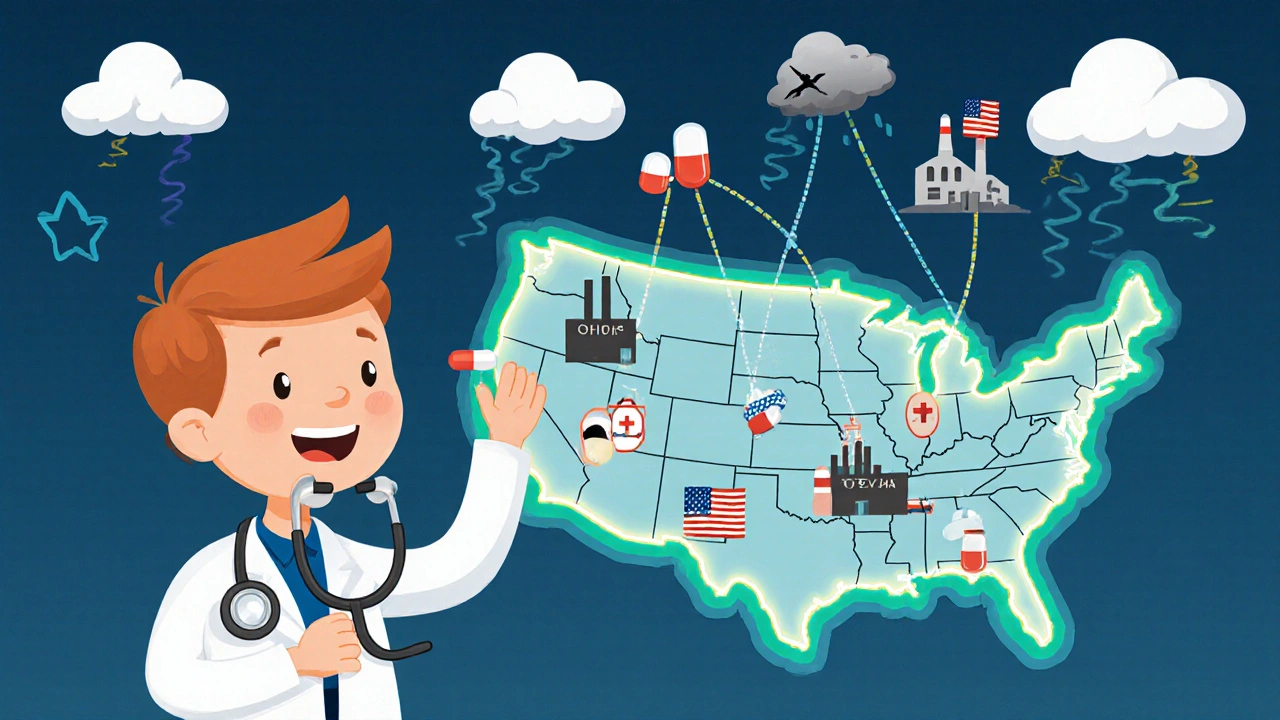Between 2023 and 2025, the U.S. Food and Drug Administration (FDA) made its biggest shift in generic drug approvals since 2012. The goal? Stop the U.S. from depending on foreign factories for life-saving medicines. If you’ve ever waited weeks for a prescription because the drug was out of stock, this change matters to you. The new rules aren’t just paperwork updates-they’re reshaping how generics are made, approved, and priced in America.
Why the FDA Changed the Rules
During the pandemic, it became painfully clear: if a drug is made overseas, you’re one natural disaster, political shift, or shipping delay away from a shortage. In 2023, over half of all drugs sold in the U.S. came from factories outside the country. India and China together controlled 66% of active pharmaceutical ingredient (API) production. The U.S. had just 9%. That’s not just a supply chain problem-it’s a public health risk.
The FDA responded with the ANDA Prioritization Pilot Program, launched in October 2025. This isn’t a suggestion. It’s a new track. If you make your generic drug in the U.S., from start to finish, your application gets fast-tracked. No more waiting 12 to 15 months. The FDA now aims to approve these applications in 8 months. That’s a 40% speed-up.
How the Prioritization Pilot Works
The program has four tiers, based on how much of the drug is made in America. The highest tier-Tier 1-requires 100% U.S. manufacturing and testing. That includes the active ingredient, the pill formulation, and the final packaging. If you meet that standard, your application gets reviewed in 30 days instead of 60 to 90. Complete response letters come in 45 days, not 120.
Here’s what you need to qualify:
- API sourced from a U.S. facility or one with verified equivalence to U.S. standards
- Bioequivalence testing done in an FDA-registered U.S. lab
- Manufacturing site inspected and compliant with Current Good Manufacturing Practices (CGMP)
The FDA doesn’t just want paperwork. They want proof. That means submitting facility records, test data, and supply chain maps. The average application now takes 217 hours just to prepare the domestic verification docs. That’s over five full workweeks.
Who Benefits the Most?
Not all generic drugs are created equal. The pilot focuses on drugs on the FDA’s Drug Shortage List-147 medications as of September 2025. These include common drugs like insulin, antibiotics, and heart medications. First generics get special attention too. In 2025 alone, the FDA approved nine first generics, including Ivermectin tablets and Nimodipine solution. These are drugs that just lost patent protection. The first company to bring a generic version to market gets a six-month monopoly. That’s worth millions.
Companies that jumped on the pilot early are seeing results. Teva Pharmaceuticals said their Nimodipine solution reached the market eight months faster than planned. Their initial review came in 28 days. That’s unheard of under the old system.
Small and mid-sized manufacturers are leading the charge. Sixty-three percent of mid-sized companies (50-500 employees) have applied to the pilot. Big pharma? Only 41%. Why? Because the cost to build a U.S. manufacturing plant is $120 million to $180 million. For a company making low-cost, high-volume generics, that’s a hard sell. But for niche drugs with higher margins, it’s a game-changer.

The Hidden Costs and Trade-Offs
There’s no free lunch. Making drugs in the U.S. costs 25-30% more than in India or China. That’s because labor, energy, and regulatory compliance are pricier here. The FDA estimates each application now costs $1.2 million to $1.8 million more due to domestic verification. That’s why 31% of manufacturers said they’ve delayed product launches.
And it’s not just about money. Sourcing API domestically is tough. Only 9% of API makers are in the U.S. That means companies have to find new suppliers, validate them, and retest formulations. Sixty-three percent of companies applying to the pilot reported trouble finding U.S.-based API suppliers for complex molecules.
Even with faster reviews, 82% of initial applications were rejected for incomplete documentation. The FDA has a team of 15 specialists just helping companies fix these issues. They’ve resolved 89% of them within 30 days. But that’s still a delay.
Impact on Drug Prices
When a first generic hits the market, prices drop fast. On average, they fall 78.3% within six months. That’s how competition works. But if domestic production adds 12-18% to the cost of making the drug, will prices stay low?
MedPAC, the Medicare advisory group, thinks yes-but only after 3-5 years. As more U.S. factories open, economies of scale kick in. The Congressional Budget Office projects the program will save $4.2 billion a year by 2030 by preventing shortages that force hospitals to buy expensive emergency stock.
Right now, the market is split. Companies with domestic supply chains have a 92% approval rate under the pilot. Those relying on foreign manufacturing? Only 68%. That’s a huge gap. It’s pushing companies to invest, even if it hurts short-term profits.
What’s Next? Complex Generics and AI
The pilot started with simple pills and capsules. But starting January 2026, it expands to complex generics: nasal sprays, eye drops, and skin patches. These are harder to copy. Bioequivalence is trickier. Stability testing takes longer. The FDA is already working on new guidance expected in November 2025.
They’re also testing AI tools to scan applications. These tools can flag missing data, mismatched test results, or inconsistent documentation in seconds. The goal? Cut review times another 25%. That could bring some approvals down to 6 months.
By 2028, the FDA expects U.S. API manufacturing to jump from 9% to 23%. That’s still not enough to cover all needs, but it’s a major shift. And it’s happening because the rules changed.

Expert Opinions: Is This a Good Move?
Not everyone agrees. Dr. Rachel Sherman, former FDA deputy commissioner, warned that pushing for domestic production could fragment global supply chains. She’s right-many countries rely on U.S. and Indian API makers. If the U.S. pulls back, it could disrupt global access to generics.
But Dr. Aaron Kesselheim from Harvard found no drop in drug effectiveness. His 2025 study showed pilot-approved generics performed just as well as older ones. The 95% confidence interval for efficacy was 0.97 to 1.03. That’s essentially identical.
The Alliance for Pharmacy Compounding is cautious. They worry that speed could lead to corners being cut. But the FDA’s own data shows major deficiencies dropped 41% in 2025 compared to 2024. Quality isn’t slipping.
What Manufacturers Should Do Now
If you’re a generic drug maker:
- Check if your product is on the FDA’s Drug Shortage List
- Map your supply chain. Can you source API from the U.S.?
- Verify your testing labs are FDA-registered and located stateside
- Start preparing your domestic verification documents early
- Use the FDA’s technical assistance program-1,243 inquiries have already been handled
If you’re a small company, consider partnering with a U.S.-based API supplier. The FDA’s updated Generic Drug Facilities Inspection Database now shows real-time status of approved sites. You can search it online.
What Patients Should Know
You might not notice the change right away. But over the next two years, you’ll see fewer drug shortages. That means fewer calls to your pharmacy saying, “We’re out.” Fewer last-minute switches to a different brand. Fewer emergency purchases at triple the price.
And while some generics may cost a little more at first, the long-term goal is stability-not higher prices. The FDA isn’t trying to make drugs expensive. They’re trying to make sure they’re always available.
The bottom line: this isn’t about politics. It’s about reliability. If you take a daily pill for blood pressure, diabetes, or epilepsy, you deserve to know it’ll be there tomorrow. That’s what the FDA is finally fixing.
What is the ANDA Prioritization Pilot Program?
The ANDA Prioritization Pilot Program is an FDA initiative launched in October 2025 that speeds up approval for generic drugs made entirely in the U.S. It gives priority review to applications where the active ingredient, formulation, and packaging are all produced domestically. Qualifying applications can be approved in as little as 8 months, compared to the standard 12-15 months.
Which drugs are eligible for faster approval?
Drugs on the FDA’s Drug Shortage List are prioritized. As of September 2025, that includes 147 medications like insulin, antibiotics, heart drugs, and seizure medications. First generic approvals-drugs just coming off patent-are also fast-tracked. Complex generics like nasal sprays and patches will be added in January 2026.
How much does it cost to switch to U.S. manufacturing?
Building a U.S. generic drug manufacturing facility costs between $120 million and $180 million. For each ANDA application, domestic verification adds $1.2 million to $1.8 million in extra costs. These include testing, documentation, facility audits, and API sourcing. Small companies often struggle with this upfront investment.
Will generic drugs become more expensive because of these changes?
Initially, yes-costs could rise 12-18% due to domestic production. But the Congressional Budget Office projects prices will normalize after 3-5 years as more U.S. factories open and scale up. Long-term, the savings from preventing drug shortages are estimated at $4.2 billion annually by 2030.
Are U.S.-made generics safer or more effective?
Yes, in terms of reliability. Studies, including one published in JAMA Internal Medicine in March 2025, show U.S.-approved generics under the pilot program have the same therapeutic effectiveness as those made overseas. The FDA’s own data shows no drop in quality-deficiencies in documentation have actually decreased by 41% since 2024.
How can I find out if my generic drug is made in the U.S.?
The FDA doesn’t require labels to say where a drug is made. But you can check the Generic Drug Facilities Inspection Database on the FDA’s website to see if the manufacturer’s facility is registered and approved in the U.S. You can also ask your pharmacist or contact the drugmaker directly.
Is this program only for big pharmaceutical companies?
No. Mid-sized companies (50-500 employees) are leading adoption, with 63% participating. Large companies are slower, at 41%. Small companies face the biggest financial hurdles, but the FDA offers technical assistance and has approved applications from smaller firms that partnered with U.S. suppliers.
What happens if my application gets rejected?
About 82% of initial applications had incomplete documentation and were rejected. The FDA has a dedicated team that helps companies fix issues-89% of these are resolved within 30 days. You can resubmit with corrected documentation. The pilot program allows for multiple submissions without losing your place in line.



Comments (8)
Philip Rindom
Finally, someone’s doing something about the generic drug mess. I’ve had to call three pharmacies just to get my blood pressure med last month. This ain’t just paperwork-it’s life or death for a lot of us. Hope this sticks.
Jess Redfearn
So if it’s made in the US it’s better? Like, duh. Why did it take a pandemic to figure this out? My grandma’s insulin was out for 3 weeks. That’s not a supply chain issue, that’s a crime.
Ashley B
Oh please. This is all a distraction. The FDA’s just letting Big Pharma buy their way into the pipeline. You think Teva’s doing this out of the goodness of their heart? They’re locking out small players and raising prices under the guise of ‘national security.’ I’ve seen the documents. This is corporate theater with a side of taxpayer money.
And don’t even get me started on how they’re ‘verifying’ API sources. Half those labs are owned by the same conglomerates that own the drug companies. It’s a closed loop. They’re just moving the same poison from one room to another.
Meanwhile, people in India and China are still getting their meds-because the U.S. decided to hoard the supply chain. You call this patriotism? I call it selfishness with a badge.
Scott Walker
Canada’s watching this closely. We’ve been relying on U.S. generics for years, and the shortages hit us hard too. 🤔 If this works, maybe we’ll start building our own API plants. Not saying it’s easy-but if the U.S. can do it, so can we. 🇨🇦
Also, props to the small companies pushing through. That’s the real hero story here.
Eric Gregorich
Let’s be real-this isn’t about drugs. It’s about identity. We’ve spent 40 years outsourcing everything because ‘efficiency’ sounded smarter than ‘resilience.’ But efficiency is a myth when your mother can’t get her heart medication because a flood in Mumbai shut down a factory. This is the moment we stopped being consumers and started being citizens.
It’s not about money. It’s about dignity. The dignity of knowing your life isn’t dependent on the whims of a foreign government, a shipping container, or a corrupt bureaucrat in a faraway office. We used to make things here. We used to fix things here. We used to believe in our own hands.
Now we’re just waiting for a pill to arrive from a country we’ve never visited, made by people we’ll never meet, under rules we don’t understand. And we wonder why we feel so hollow.
This pilot? It’s not just a policy change. It’s a spiritual reckoning. We’re choosing to build again. Not for profit. Not for stock prices. But because we owe it to the people who take these pills every day. Even if it costs more. Even if it’s harder.
Because some things-like life-shouldn’t be optimized. They should be honored.
Koltin Hammer
Man, this reminds me of when we started making our own bread instead of buying it. At first, it tasted weird, took forever, and cost more. But then you realize-you’re not just eating bread. You’re eating autonomy. You’re eating sovereignty.
Same with these drugs. We outsourced our medicine like we outsourced our factories, our tech, our dreams. And now we’re paying the price in panic, in hospital visits, in elderly folks skipping doses because they’re scared.
It’s not just about 9% vs 23% API production. It’s about trust. Trust that your medicine won’t vanish because some guy in Shanghai decided to shut down for ‘maintenance.’ Trust that your kid’s asthma inhaler won’t be a lottery ticket.
And yeah, it’s expensive. But so is a 72-hour ER wait because the hospital ran out of antibiotics. So is a grandma dying because her insulin expired and no one could get a new one.
The FDA’s not fixing supply chains. They’re fixing our collective amnesia. We forgot we could make things. Now we’re remembering.
And honestly? I’m proud of the small companies doing this. They’re not in it for the IPO. They’re in it because they’ve seen the faces behind the shortages. That’s the real innovation here.
Willie Randle
Just to clarify: the ANDA Prioritization Pilot does not guarantee lower drug prices. It guarantees *availability*. Price reductions come from competition, not policy. The FDA’s role is to ensure safety and timeliness-not to control cost. That’s market dynamics.
Also, the 82% rejection rate for initial applications is misleading. Most applicants submit incomplete or poorly formatted documentation-not because they’re negligent, but because the new requirements are complex and unprecedented. The FDA’s 89% resolution rate within 30 days shows they’re actively helping, not blocking.
And while $1.8M in added cost per application sounds high, it’s a one-time investment. Once the supply chain is established, marginal costs drop. Compare that to the $12B/year U.S. healthcare system spends on emergency drug purchases due to shortages.
This isn’t protectionism. It’s risk mitigation. And the data supports it: fewer deficiencies, faster approvals, no drop in efficacy. The only real resistance comes from companies who benefited from the old, broken system.
kanishetti anusha
As someone from India, I want to say this isn’t about ‘us vs them.’ Our labs make quality generics-millions rely on them. But I also get why the U.S. is doing this. We’ve seen how fragile global chains are. When the pandemic hit, even our exports slowed down.
Maybe the answer isn’t ‘make everything in the U.S.’ but ‘make more things in more places.’ Diversify, don’t isolate. I hope the FDA keeps working with international partners, not just replacing them.
Also, big thanks to the FDA for offering technical help. Many small U.S. firms don’t know where to start. That support? That’s leadership.